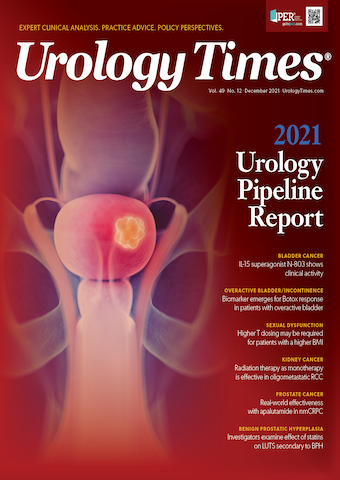Publication
Article
Urology Times Journal
Transitional Zone sampling can be spared in some men with suspicious prostate cancer lesions on mpMRI
Author(s):
Transitional zone sampling might not be necessary for prostate cancer detection in men with exclusively peripheral prostate cancer–suspicious lesions on multiparametric magnetic resonance imaging (mpMRI) who undergo targeted and systematic prostate biopsies, according to a study published in the Journal of Urology.1
The study of 863 men found peripheral targeted and systematic prostate biopsies without transitional zone sampling yielded similar cancer detection to the sampling protocol with transitional zone sampling. And the “zone-dependent” approach might reduce biopsy-related morbidity, the authors wrote.
Researchers in Germany and Australia studied men who underwent extended systematic biopsies and transitional zone sampling, in addition to mpMRI/ultrasound fusion targeting of at least one mpMRI categorized suspicious lesion in the peripheral zone. The men had no suspicious lesions on mpMRI in the transitional zone.
The authors defined clinically significant prostate cancer as a Gleason score of more than or equal to 3+4.
They retrospectively compared clinically significant prostate cancer detection rates between two biopsy protocols. One was a combination of peripheral mpMRI targeted and extended systematic prostate biopsy, including transitional zone sampling. The other was peripheral mpMRI targeted plus systemic prostate biopsy without transitional zone sampling.
Researchers found:
- The extended protocol yielded prostate cancer detection for clinically significant prostate cancer at 48% versus 47% among those who did not have transitional zone sampling.
- Gleason score 3+3 in the extended protocol group was 21% versus 20% with omission of systematic transitional zone sampling.
- Transitional zone systematic prostate cancer sampling detected an additional 2.0% of cancer.
“This zone-dependent biopsy strategy warrants prospective evaluation to optimize the extent of systematic biopsies in presence of suspicious mpMRI lesions,” the authors wrote.
Michael S. Cookson, MD, professor and chairman of the Department of Urology at the University of Oklahoma Health Sciences Center, and co–editor-in-chief of Urology Times, said in an interview with Urology Times that there is debate about how extensive and how many biopsies need to be obtained in the era of mpMRI.
Michael S. Cookson, MD

“When lesions are easily visible on MRI, particularly Prostate Imaging-Reporting and Data System [PI-RADS] 4 and 5 lesions, the cancer diagnosis is almost always found in the target,” said Cookson, who is not an author on the paper. “There are, however, questions about the additional information gain from systematic biopsies. In this retrospective study in patients with peripheral zone target lesions, there did not appear to be any significant yield to routine sampling of the transitional zone.”
The study is important because each biopsy adds to the potential morbidity of the procedure, including bleeding infection and urinary retention, according to Cookson.
“The transition zone is an area that is particularly susceptible to urinary bleeding and outlet obstruction, so avoidance of this at least has the potential to reduce the risk of this post-biopsy complication. In addition, transition zone–only tumors are relatively rare, and in the absence of any demonstrable suspicion on mpMRI could probably be avoided,” Cookson said.
While not addressed in this paper, future analyses should look at the potential for reducing complications by avoiding transition zone biopsies in this setting, noted Cookson.
Reference
Kachanov M, Leyh-Bannurah SR, Roberts MJ, at al. Optimizing combined magnetic resonance imaging-targeted and systematic biopsy strategies: Sparing the multiparametric magnetic resonance imaging-negative transitional zone in presence of exclusively peripheral multiparametric magnetic resonance imaging-suspect lesions [published online ahead of print September 24, 2021]. J Urol. doi: 10.1097/JU.0000000000002248






























